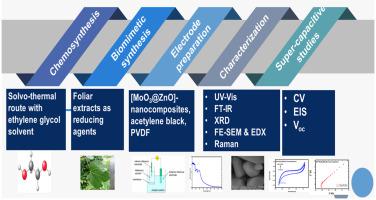当前位置:
X-MOL 学术
›
Renew. Energy
›
论文详情
Our official English website, www.x-mol.net, welcomes your feedback! (Note: you will need to create a separate account there.)
Biomimetic [MoO3@ZnO] semiconducting nanocomposites: chemo-proportional fabrication, characterization and energy storage potential exploration
Renewable Energy ( IF 8.7 ) Pub Date : 2021-04-01 , DOI: 10.1016/j.renene.2020.11.115 Irum Shaheen , Khuram Shahzad Ahmad , Shaan Bibi Jaffri , Daoud Ali
Renewable Energy ( IF 8.7 ) Pub Date : 2021-04-01 , DOI: 10.1016/j.renene.2020.11.115 Irum Shaheen , Khuram Shahzad Ahmad , Shaan Bibi Jaffri , Daoud Ali

|
Abstract Current work reports the first investigation on the nanocomposites of molybdenum and zinc oxide [MoO3@ZnO] synthesized via chemosynthetic and biomimetic routes. Chemosynthetic and biomimetic MoO3@ZnO nanocomposites expressed a direct band gap of 4.5 and 3.5 eV, explored via ultraviolet spectrophotometry capped with organic functional groups shown by Fourier transform infra-red spectroscopy. Polycrystalline patterns expressing average crystallite sizes of 36.9 and 22.5 nm for nanocomposites were revealed by X-ray diffraction. Nanocomposites expressed capsule and spherical shapes shown by field emission scanning electron micrographs with strong signals for Mo, Zn and O shown via energy dispersive X-ray spectroscopy. Raman spectroscopy revealed the successful synthesis of the MoO3@ZnO nanocomposite. Electrochemical studies included cyclic voltammetry (CV) and electrochemical impedance spectroscopy (EIS). Redox peaks revealed the pseudo-capacitive behavior shown. EIS Nyquist plot with an arc radius pointed the existence of resistance mechanism arising from interfacial layer taking place at the electrode MoO3@ZnO nanocomposite surficial region with charge transfer resistance Rct of = 22.02 Ω. The semi-conducting and capacitive behavior of the biogenic nanocomposite makes it a future candidate for utilization in solar cells and other photovoltaic devices marked by profound sustainability, eco-friendliness, economic viability and scalability in comparison to environmentally damaging chemosynthetic solvo-thermal pathway.
中文翻译:

仿生 [MoO3@ZnO] 半导体纳米复合材料:化学比例制造、表征和储能潜力探索
摘要 目前的工作报告了对通过化学合成和仿生途径合成的钼和氧化锌纳米复合材料 [MoO3@ZnO] 的首次研究。化学合成和仿生 MoO3@ZnO 纳米复合材料的直接带隙为 4.5 eV 和 3.5 eV,通过紫外分光光度法进行探索,有机官能团由傅里叶变换红外光谱显示。通过 X 射线衍射揭示了表示纳米复合材料平均微晶尺寸为 36.9 和 22.5 nm 的多晶图案。纳米复合材料通过场发射扫描电子显微照片显示胶囊和球形形状,通过能量色散 X 射线光谱显示 Mo、Zn 和 O 的强信号。拉曼光谱揭示了 MoO3@ZnO 纳米复合材料的成功合成。电化学研究包括循环伏安法 (CV) 和电化学阻抗谱 (EIS)。氧化还原峰揭示了所示的赝电容行为。具有圆弧半径的 EIS Nyquist 图表明存在由界面层引起的电阻机制,该电阻机制发生在电极 MoO3@ZnO 纳米复合材料表面区域,电荷转移电阻 Rct 为 22.02 Ω。与破坏环境的化学合成溶剂热途径相比,生物纳米复合材料的半导体和电容行为使其成为太阳能电池和其他光伏器件的未来候选者,这些器件具有深刻的可持续性、生态友好性、经济可行性和可扩展性。具有圆弧半径的 EIS Nyquist 图表明存在由界面层引起的电阻机制,该电阻机制发生在电极 MoO3@ZnO 纳米复合材料表面区域,电荷转移电阻 Rct = 22.02 Ω。与破坏环境的化学合成溶剂热途径相比,生物纳米复合材料的半导体和电容行为使其成为太阳能电池和其他光伏器件的未来候选者,这些器件具有深刻的可持续性、生态友好性、经济可行性和可扩展性。具有圆弧半径的 EIS Nyquist 图表明存在由界面层引起的电阻机制,该电阻机制发生在电极 MoO3@ZnO 纳米复合材料表面区域,电荷转移电阻 Rct = 22.02 Ω。与破坏环境的化学合成溶剂热途径相比,生物纳米复合材料的半导体和电容行为使其成为太阳能电池和其他光伏器件的未来候选者,这些器件具有深刻的可持续性、生态友好性、经济可行性和可扩展性。
更新日期:2021-04-01
中文翻译:

仿生 [MoO3@ZnO] 半导体纳米复合材料:化学比例制造、表征和储能潜力探索
摘要 目前的工作报告了对通过化学合成和仿生途径合成的钼和氧化锌纳米复合材料 [MoO3@ZnO] 的首次研究。化学合成和仿生 MoO3@ZnO 纳米复合材料的直接带隙为 4.5 eV 和 3.5 eV,通过紫外分光光度法进行探索,有机官能团由傅里叶变换红外光谱显示。通过 X 射线衍射揭示了表示纳米复合材料平均微晶尺寸为 36.9 和 22.5 nm 的多晶图案。纳米复合材料通过场发射扫描电子显微照片显示胶囊和球形形状,通过能量色散 X 射线光谱显示 Mo、Zn 和 O 的强信号。拉曼光谱揭示了 MoO3@ZnO 纳米复合材料的成功合成。电化学研究包括循环伏安法 (CV) 和电化学阻抗谱 (EIS)。氧化还原峰揭示了所示的赝电容行为。具有圆弧半径的 EIS Nyquist 图表明存在由界面层引起的电阻机制,该电阻机制发生在电极 MoO3@ZnO 纳米复合材料表面区域,电荷转移电阻 Rct 为 22.02 Ω。与破坏环境的化学合成溶剂热途径相比,生物纳米复合材料的半导体和电容行为使其成为太阳能电池和其他光伏器件的未来候选者,这些器件具有深刻的可持续性、生态友好性、经济可行性和可扩展性。具有圆弧半径的 EIS Nyquist 图表明存在由界面层引起的电阻机制,该电阻机制发生在电极 MoO3@ZnO 纳米复合材料表面区域,电荷转移电阻 Rct = 22.02 Ω。与破坏环境的化学合成溶剂热途径相比,生物纳米复合材料的半导体和电容行为使其成为太阳能电池和其他光伏器件的未来候选者,这些器件具有深刻的可持续性、生态友好性、经济可行性和可扩展性。具有圆弧半径的 EIS Nyquist 图表明存在由界面层引起的电阻机制,该电阻机制发生在电极 MoO3@ZnO 纳米复合材料表面区域,电荷转移电阻 Rct = 22.02 Ω。与破坏环境的化学合成溶剂热途径相比,生物纳米复合材料的半导体和电容行为使其成为太阳能电池和其他光伏器件的未来候选者,这些器件具有深刻的可持续性、生态友好性、经济可行性和可扩展性。


























 京公网安备 11010802027423号
京公网安备 11010802027423号